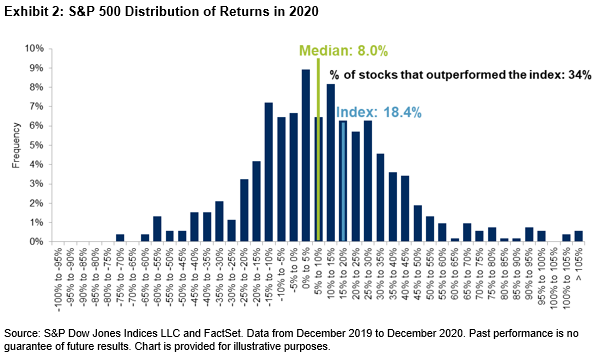In October 2019, S&P Dow Jones Indices launched the S&P ESG Global Macro Index, an ESG-themed, regionally diversified, volatility-managed, multi-asset index. As discussed in my previous blog, the index has generated stable absolute returns of 5.44% annually, a volatility of 4.89%, and downside protection during extreme market scenarios, based on back-tested performance from Aug. 31, 2010, to Dec. 31, 2020.
The global equities market experienced unprecedented fast drawdown and recovery in 2020. Although the S&P ESG Global Macro Index’s performance was not as stunning as that of the S&P 500® in 2020, it outperformed a pure equity and static 60% equity/40% bond portfolio with a risk control mechanism.1 This blog reviews how the S&P ESG Global Macro Index’s dynamic asset allocation helped to achieve this outcome.

Economic- and Market-Signal-Based Allocation
The S&P ESG Global Macro Index uses a short-term economic movement signal and a medium-term market trend signal to revise its asset allocation on a monthly basis (see brochure). Exhibit 2 provides the timeline of allocation signals of the S&P ESG Global Macro Index in 2020. There were three different phrases.
Phase 1: Before Sell-Off
At the beginning of 2020, the Organization for Economic Co-operation and Development’s composite leading indicator (the OECD’s CLI) was below 100, indicating economic activity was below its long-term potential level. Although the three-month momentum of the equity market was still positive, the index allocated 55% to equities and 45% to fixed income.
Phase 2: COVID-19 Sell-Off
The sell-off started on Feb. 19, and hit bottom on March 23. The S&P 500 declined 33.93% in 23 trading days. The S&P ESG Global Macro Index reduced its equity allocation from 55% to 0% on March 1, as the momentum signal turned negative during that month’s rebalance.
Phase 3: Recovery
On Aug. 18, the S&P 500 completely erased its February-March 2020 losses, calling an end to the COVID-19-driven plunge. As the market signal turned positive on July 1, the index reassigned a 55% weight to the equity basket to capture the upside potential gain from equities.

Risk Control Mechanism
After the monthly allocation is determined, the S&P ESG Global Macro Index applies a 5% risk control overlay by adjusting a leverage factor applied to the overall portfolio in order to achieve a stable risk at the index level. Exhibit 3 shows the allocation to each asset class after applying 5% risk control. There were three periods worth noting.
Period 1: From Feb. 19 to March 10, when the market started to fall in response to COVID-19, there was a clear negative relationship between equities and fixed income. The S&P 500 dropped 14.88% while the bond component2 gained 3.83% in 14 trading days. Before March, the index had a decreased leverage factor for protection. As the index switched to the bond portfolio starting March 1, it was leveraged. This is because the 100% bond portfolio’s volatility was less than 5%. The leverage resulted in a 2.3% return for the index from March 1 to March 10.
Period 2: From March 11 to 23, as oil prices fell, the negative relationship did not hold. The S&P 500 dropped 22.37%. During the same period, the bond stopped acting as a safe heaven and dropped by 1.37%, and the realized volatility of the all-bond portfolio was higher than 5%. The S&P ESG Global Macro Index thereby reduced its bond exposure by lowering the leverage factor and returned -1.30% during those nine trading days.
Period 3: After March 24, the market started to rebound, and the bond portfolio’s volatility decreased gradually. In response, the index continued to increase the leverage factor to maintain the 5% target volatility. From March 24 to June 30, the index kept its portfolio configuration unchanged, while increasing the leverage factor from 0.52 to 1.35. On July 1, the equity basket was added back to the index based on the positive market signal. The new equity/bond portfolio had a volatility higher than 5%. Thus, the index used a smaller leverage factor to maintain a stable level of risk, resulting in a 20.08% actual allocation to equity.

During volatile periods, especially in undesirable macroeconomic conditions, a dynamic allocation strategy, which balances risk and return during drawdowns and recoveries, could be worth consideration.
1 Risk control is commonly used in structured product’s underlying methodology, and a higher citation like 10% or 15% may lead to higher returns.
2 Represented by the index bond basket, including the S&P 10-Year U.S. Treasury Note Futures Index, S&P Euro-Bund Futures Index, and S&P 10-Year JGB Futures Index, following a ratio of 3:2:1.
The posts on this blog are opinions, not advice. Please read our Disclaimers.






















































